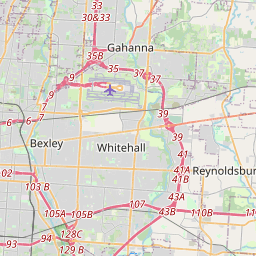The National Road
Historical marker location:
2300 West Broad Street, Columbus, Ohio
( Marker is at the intersection of Broad Street and Wheatland Avenue, on the right when traveling west on Broad Street.)
Marker installed: 2002






© OpenStreetMap contributors
Loading...
Searching for other points of interest within 3 miles of this location.The first professional baseball team, the Cincinnati Red Stockings, was formed in Ohio in 1869.
About Franklin County
Franklin County Timeline
Franklin County, located in central Ohio, has a rich and diverse history that spans centuries. The area was once inhabited by Indigenous peoples, including the Shawnee and Wyandot tribes, who were later displaced by European settlement. The first European settlers arrived in the late 18th century, and the county was organized in 1803 as part of the Northwest Territory.
In its early years, Franklin County played a significant role in the development of Ohio. It served as the state capital when Ohio became a state in 1803 until 1816. The County's central location made it an ideal hub for trade and commerce, and its proximity to transportation routes, such as the National Road and later the railroads, further solidified its importance.
Throughout the 19th and 20th centuries, Franklin County experienced significant growth and urbanization. The population expanded rapidly, particularly in the city of Columbus, which became the county seat. Columbus became a major center for industry, education, and government. The Statehouse, which was completed in the late 19th century, stands as a symbol of the county's role as the state capital.
Franklin County has also been instrumental in shaping American politics. It served as a political battleground during the Civil War and has remained an important region for political activity ever since. Today, Franklin County continues to grow and thrive as a vibrant community filled with diverse industries, cultural attractions, and a strong focus on education and research.
In its early years, Franklin County played a significant role in the development of Ohio. It served as the state capital when Ohio became a state in 1803 until 1816. The County's central location made it an ideal hub for trade and commerce, and its proximity to transportation routes, such as the National Road and later the railroads, further solidified its importance.
Throughout the 19th and 20th centuries, Franklin County experienced significant growth and urbanization. The population expanded rapidly, particularly in the city of Columbus, which became the county seat. Columbus became a major center for industry, education, and government. The Statehouse, which was completed in the late 19th century, stands as a symbol of the county's role as the state capital.
Franklin County has also been instrumental in shaping American politics. It served as a political battleground during the Civil War and has remained an important region for political activity ever since. Today, Franklin County continues to grow and thrive as a vibrant community filled with diverse industries, cultural attractions, and a strong focus on education and research.
Franklin County Timeline
This timeline provides a glimpse into the major events and milestones that have shaped the history of Franklin County, Ohio.
- 1803: Franklin County is established on April 30.
- 1808: The Ohio Statehouse construction begins.
- 1812: The first issue of the "Ohio Monitor" newspaper is published.
- 1816: The Columbus Dispatch newspaper is established.
- 1834: The Ohio State Archives is founded.
- 1837: The Ohio Statehouse construction is completed.
- 1851: The National Road reaches Columbus.
- 1862: The Camp Chase Confederate prison opens.
- 1873: The Franklin County Courthouse construction is completed.
- 1899: The Columbus Metropolitan Library is established.
- 1916: The Ohio Theatre opens in Columbus.
- 1950: The population of Franklin County exceeds half a million.
- 1964: The Ohio Expo Center & State Fairgrounds is created.
- 1974: The Franklin County Veterans Memorial is dedicated.
- 2012: The Columbus Clippers win the Triple-A baseball championship.